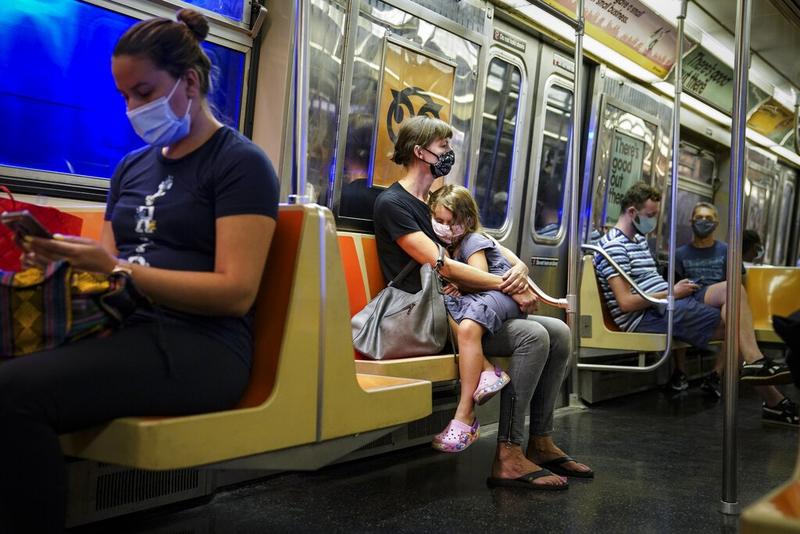 A child rests on a subway car while riders wear protective masks due to COVID-19 concerns, Aug 17, 2020, in New York. (JOHN MINCHILLO / AP PHOTO)
A child rests on a subway car while riders wear protective masks due to COVID-19 concerns, Aug 17, 2020, in New York. (JOHN MINCHILLO / AP PHOTO)
New York City transit officials are pursuing two apparently contradictory goals: Draw large numbers of people back to the subway while not packing them shoulder-to-shoulder during rush hours.
About 90% of the subway's 5.5 million weekday passengers stopped using the system when state and local officials ordered the economy to largely shut down in March as part of the effort to curb the coronavirus
It's part of the effort to curb the spread of the novel coronavirus and to get the city up and running amid a pandemic.
The city cannot fully recover until riders return to mass transit. Without hordes of people flooding into Manhattan five days a week, tax revenues have crashed and punched a huge hole in city and state budgets.
But mutually conflicting concerns suggest there will be no quick turnaround. People will not return to Manhattan in pre-pandemic numbers until they feel safe using public transit-and many remain wary.
Damien McMillon, 53, a transit worker usually assigned to the West 181st Street station on the A line, said at least 10 of his friends and several more acquaintances were among the 131 subway and bus employees killed by COVID-19 while keeping the system running.
ALSO READ: New York starts to shake off virus; Europe recovering
"You are always going to feel nervous," he said.
"You try to avoid tough situations. You do what you do and hope for the best." He wears a mask and maintains at least 1.8 meters between co-workers and riders.
"You have to pay your bills, so you take the risk," said McMillon. "We have to be on the same page with this thing or it just goes around and around. It makes you paranoid-there's so much uncertainty."
About 90 percent of the subway's 5.5 million weekday passengers stopped using the system when state and local officials ordered the economy to largely shut down in March as part of the effort to curb the coronavirus.
Before the pandemic, the subway ran 24 hours a day. Now, the system is closed each night between 1 am and 5 am to clean stations and subway cars.
Ridership has recovered slightly but is still about 75 percent below pre-pandemic levels, according to the Metropolitan Transportation Authority, or MTA.
On a downtown-bound A train, a 33-year-old man who identified himself only as Marvin, said that he was not too worried about getting a coronavirus infection.
"There are fewer people than usual riding the train," he said, gesturing to seats in the half-empty car during the morning rush.
He manages a homeless shelter in Brooklyn, which makes him an essential worker.
"My wife does not say much about how I ride the subway five days a week," Marvin said.
"I've got to make money to pay the bills. I ride the subway every day, and I am not nervous. I am careful, and I stay away from other people as much as possible and avoid big crowds."
At Times Square, Shawn Smith, 36, shrugged off concerns.
"I am a New Yorker," he said. "It takes more than a pandemic to make me nervous."
'There's good out there'
A subway advertisement behind a woman scrolling through photos on her iPhone reads, "THERE'S GOOD OUT THERE".
So far, few riders have found good as evidenced by some of their dispirited demeanor. Nevertheless, the subway continues to generate odd scenes.
At the Fulton Street station near the Sept 11 memorial in lower Manhattan, a trumpeter played The Girl From Ipanema-Antonio Carlos Jobim's hit Brazilian bossa nova song from the 1960s-as a young woman wearing a floppy hat pulled over her ears, goggles, a mask and latex gloves stepped into a Brooklynbound train.
Acutely aware of her surroundings, she recoiled when asked about her protective gear.
"Get away!" she said.
Fares cover about 40 percent of the system's operating cost. The decline in ridership puts the subway deeply in the red and threatens to slow upgrades needed to make the trains more reliable and attractive to riders, creating a double bind for the transit system.
READ MORE: New York robbed of its hustle and bustle
"At the beginning of 2020, we expected a US$100 million operating surplus in 2020," MTA Chairman Patrick Foye told Yahoo Finance.
"We had a US$51.1 billion capital plan, the largest by far in MTA history. Now, everything has to be on the table. We've got a US$12 billion ask into the federal government to cover the deficits in the remainder of 2020 and 2021. If we do not get that level of funding, we have got to delay or defer the capital plan."


